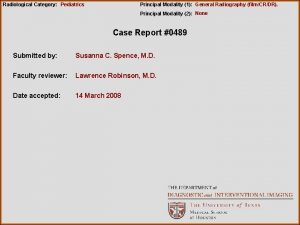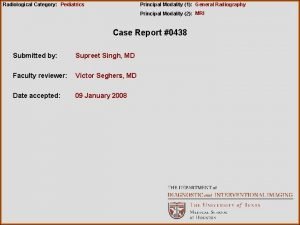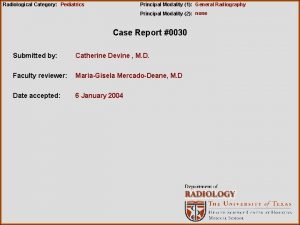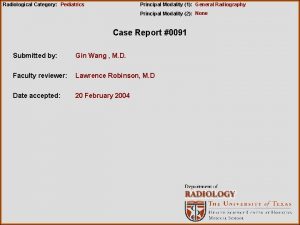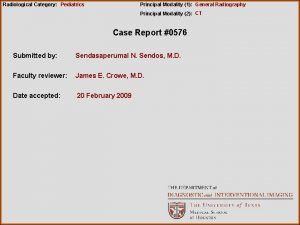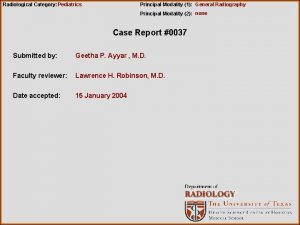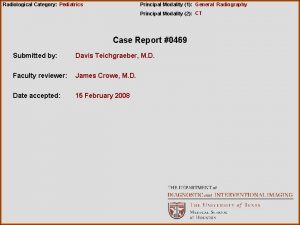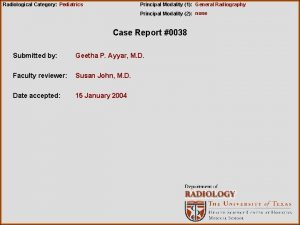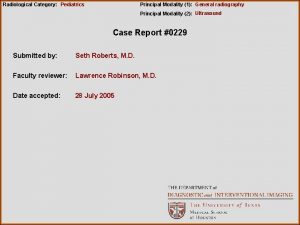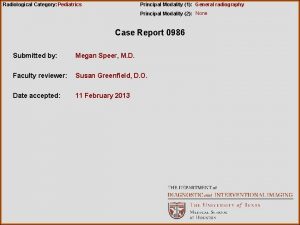Radiological Category Pediatrics Principal Modality 1 General Radiography











- Slides: 11

Radiological Category: Pediatrics Principal Modality (1): General Radiography Principal Modality (2): None Case Report #0179 Submitted by: M. YAHYA SAWAF , M. D. Faculty reviewer: LAWRENCE ROBINSON, M. D Date accepted: 24 NOVEMBER 2004

Case History One month old infant with projectile vomiting for three days.

Radiological Presentations

Radiological Presentations 2 DAYS LATER

Radiological Presentations

Test Your Diagnosis Which one of the following is your choice for the appropriate diagnosis? After your selection, go to next page. • [Pylorospasm. ] • [hypertrophic pyloric stenosis] • Pyloric atresia]

Findings and Differentials Findings: The pyloric muscle thickness is 4. 5 mm and the pyloric channel length is 16. 7 mm. No fluid was observed passing through the pyloric channel, consistent with gastric outlet obstruction. Differentials: • hypertrophic pyloric stenosis. • Pylorospasm.

Diagnosis Hypertrophic Pyloric Stenosis.

Discussion Hypertrophic pyloric stenosis is an acquired condition seen between 2 -8 weeks after birth. Symptoms include projectile vomiting, regurgitation, difficulty in feeding. Bile is usually absent in the vomitus. Prolonged pyloric muscle spasm leading to muscle hypertrophy may be the most important factor in the development of pyloric stenosis. Diagnostic features on ultrasound include: persistent spasm of the pyloric canal with little if any fluid passing into the duodenum, elongation of the pyloric canal more than 1. 2 cm. , persistent thickening of the circular muscle more than 3 mm. The double track sign is noted by ultrasound and is due to sonolucent fluids trapped in compressed mucosal folds. Pylorospasm the most common cause for gastric outlet obstruction in infancy and is multifactorial in etiology. It may be the precursor of pyloric stenosis. However muscular wall is not thickened and, when observed over several minutes peristalsis will pass through the antrum, revealing a pyloric channel of normal length. The obstruction is not fixed, and gastric contents will be observed passing through the pylorus.

Discussion Gastric atresia is classified into 2 types: complete atresia, in which a fibrous band connects the stomach and duodenum; and incomplete, in which a membrane or diaphragm partially obstructs the antrum.

Discussion References: Swischuck, L. imaging of the newborn, infant and young child.
 Erate category 2 eligible equipment
Erate category 2 eligible equipment National radiological emergency preparedness conference
National radiological emergency preparedness conference Radiological dispersal device
Radiological dispersal device Tennessee division of radiological health
Tennessee division of radiological health Center for devices and radiological health
Center for devices and radiological health Characteristics of sensory neurons
Characteristics of sensory neurons Sodality vs modality
Sodality vs modality Epistemic modality
Epistemic modality One to many relationship line
One to many relationship line Cardinality and modality
Cardinality and modality Modality erd
Modality erd Modality microsoft services
Modality microsoft services












